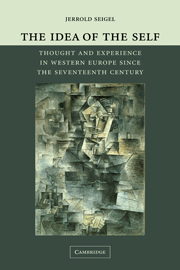Book contents
- Frontmatter
- Contents
- Acknowledgments
- PART I INTRODUCTORY
- PART II BRITISH MODERNITY
- PART III SOCIETY AND SELF-KNOWLEDGE: FRANCE FROM OLD REGIME TO RESTORATION
- PART IV THE WORLD AND THE SELF IN GERMAN IDEALISM
- PART V MODERN VISIONS AND ILLUSIONS
- 13 Dejection, insight, and self-making: Coleridge and Mill
- 14 From cultivated subjectivity to the culte du moi: polarities of self-formation in nineteenth-century France
- 15 Society and selfhood reconciled: Janet, Fouillé, and Bergson
- 16 Will, reflection, and self-overcoming: Schopenhauer and Nietzsche
- 17 Being and transcendence: Heidegger
- 18 Deaths and transfigurations of the self: Foucault and Derrida
- 19 Epilogue
- Notes
- Index
17 - Being and transcendence: Heidegger
Published online by Cambridge University Press: 05 June 2012
- Frontmatter
- Contents
- Acknowledgments
- PART I INTRODUCTORY
- PART II BRITISH MODERNITY
- PART III SOCIETY AND SELF-KNOWLEDGE: FRANCE FROM OLD REGIME TO RESTORATION
- PART IV THE WORLD AND THE SELF IN GERMAN IDEALISM
- PART V MODERN VISIONS AND ILLUSIONS
- 13 Dejection, insight, and self-making: Coleridge and Mill
- 14 From cultivated subjectivity to the culte du moi: polarities of self-formation in nineteenth-century France
- 15 Society and selfhood reconciled: Janet, Fouillé, and Bergson
- 16 Will, reflection, and self-overcoming: Schopenhauer and Nietzsche
- 17 Being and transcendence: Heidegger
- 18 Deaths and transfigurations of the self: Foucault and Derrida
- 19 Epilogue
- Notes
- Index
Summary
Next to Nietzsche, the most influential figure in contemporary thinking about selfhood and subjectivity has been Martin Heidegger. Both Jean-Paul Sartre, who developed a subject-centered existentialism, and the “post-structuralist” French figures who sought to proclaim or advocate the “death of the subject,” including Michel Foucault and Jacques Derrida, were indebted to him. Since the post-structuralists were sharp critics of Sartre, it is clear that Heidegger was susceptible to being read in contrasting ways; the ambiguities of his legacy are compounded when we remember that he was a deep conservative, and for a time a public supporter of Nazism (a position he never clearly renounced), whereas many seeking to draw on him have located themselves on the political far left. Indeed he had considerable difficulty in stabilizing the implications of his thinking himself. A chief goal of the position he developed in his most famous book, Being and Time (1927), was to displace the human subject from the central position it had occupied in philosophy since Descartes, and to replace the notion of stable selfhood with a different, fluid, and “temporal” understanding of the self. But during the 1930s he himself concluded that the residues of subject-centered thinking were still too powerful in that book, leading him to seek different ways to purge them, by expanding his reliance on mystical traditions, both Western and Eastern, and by focusing on language as the active agent of thinking, the voice of being.
- Type
- Chapter
- Information
- The Idea of the SelfThought and Experience in Western Europe since the Seventeenth Century, pp. 568 - 602Publisher: Cambridge University PressPrint publication year: 2005

